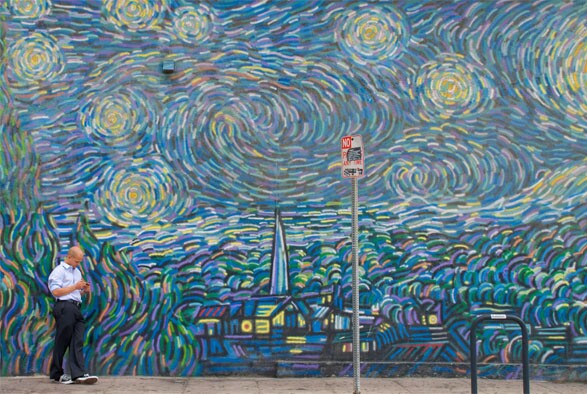New Motion Seeks To Identify L.A.'s Murals As Art, Not Signs

The art of large-scale storytelling is struggling in the very city that shaped the craft.
Cultural identity in Los Angeles was once about neighborhoods having a voice on walls. But those urban canvases have been shadowed by commercial media, and the decades-old imagery has faded under sun, painted over by red tape, or tagged into oblivion. All told, L.A. streets as a source and inspiration for outdoor murals is vanishing.
Now artistic and civic Angelenos want to restore the silent walls, despite being buried under ordinances that came from legal clutter interpreting free speech.
The current charge up the hill is led by City Councilmember Bill Rosendahl, whose District 11 includes Venice, home to the grand mural tradition with works from artists and institutions like Rip Cronk, Jane Golden, Los Angeles Fine Arts Squad, Emily Winters, and the Social and Public Art Resource Center (SPARC).
On June 1, Rosendahl introduced a motion to have the city of Los Angeles develop a "legally-defensible method" that would encourage murals to be created; in part by defining mural content as art, separating it from commercial signage.
If the city departments of Planning, Building and Safety, Cultural Affairs, and the City Attorney come to a consensus on how outdoor images with commercial intent, "supergraphics" and billboards would not overlap with those containing artistic intent. As of now, the term mural is forced to share an identity with large-scale outdoor advertising, thanks to a 2002 ordinance that refers to the outdoor visual medium as "mural signs."
"Advertising may be artful, but it is not the same as art," said Rosendahl days after his motion was filed. "They deserve to be viewed separately from commercial signage. It's not about selling soap. Murals are an expression--the stories--of communities."
Emily Winters is the renowned Venice-based muralist known for "Jaya" (1975) and "Endangered Species" (1990), two murals produced through the SPARC's Neighborhood Pride Program and the Cultural Affairs Department. Of all muralists, she understands the difference between advertising and murals, having begun her career as a billboard painter for record companies and outdoor advertising. "There needs to be a clearer distinction between signs and murals," said Winters to Santa Monica- and Venice-based newspaper, The Argonaut.
Or as SPARC co-founder and muralist Judy Baca has said at different stages of advocating for murals to be released from same city codes as advertising: "If it's about beauty or social interaction, it's a mural. If it's designed to sell a product, then it's advertising, pure and simple."
As any one who follows the plight of mural-blight know, the city's legacy was sacrificed when trying to harness advertising using large-scale composition for commercial use.
In Hollywood, the Night Gallery's portraits of film icons painted on roll-down doors along the Walk of Fame was commissioned by the district's Art Council with help from the L.A.'s Community Redevelopment Agency. "Such a project could not be entertained under the current interpretation of the signage ordinance. The gallery was a catalytic project in our revitalization of Hollywood Boulevard," said Susan Gray, Cultural Arts Planner with the CRA, who credits the monochrome murals for softening the fortress-like image of Hollywood Boulevard after dark. "It's really too bad that we can't continue these sorts of projects in other CRA project areas."
"Thoughtfully placed, well crafted and well maintained murals also articulate a message that a neighbor is safe, vibrant, and an interesting destination," Gray added.
This is not the first time the city tried to unravel itself. As recently as 2008, Councilmember Tom LaBonge sought to revive murals in Los Angeles after grassroots artists who painted on private property were ordered to whitewash their work; and previous murals that were tagged were ordered by the city to be restored or removed.
Like Rosendahl's current motion, earlier discussions considered adopting Portland, Oregon's mural code, which separates murals and signs. Even then, the Department of Cultural Affairs were instructed to work with the Planning Department "and with other city departments to continue to review all the universes of existing murals" and form a permitting process allowing new murals.
Distracted by ongoing litigation with sign companies that led to support from the 9th Circuit Court of Appeals in the city's battle with billboards, the plan faded away, but it may now mean the window opened for a change in policy.
"I'm doing it for my constituency," said Rosendahl, "people like the Emily Winters, the Judith Bacas, who have put their time, their energy, their passion into their work."
Also waiting for things to change are the active muralists with roots in street art and graffiti. They have the added crucible with law enforcement quickly linking their works to gang tagging, and partly due to street artist guerrilla-style installation, which is seen as random acts of vandalism.
"Where do they fit in with the motion?" Rosendahl was asked with a reminder that some street artists and muralists working with aerosol have created solid works and have sought to work through permits.
"That's a good question," he mused.
It will come up again, as meetings between muralists, curators, and city departments are being planned to move Rosendahl's goal for a citywide program in the future.
"I do believe the recent motion is a solid step in reviving a mural process," said Pat Gomez, Arts Manager at Cultural Affairs. "We have not been looking at graff-style works differently from traditional brush painted murals in identifying a process."
The stage to discuss the evolved content of murals hasn't been reached, making now a decisive moment for murals in Los Angeles.

Twitter: @KCETdepartures
Facebook: KCETdepartures
Top Photo: Homage to a Starry Night (1990) by Rip Cronk is his well known tribute to Vincent van Gogh in Venice, California. Photo by Kevin McShane licensed under Creative Commons.